-
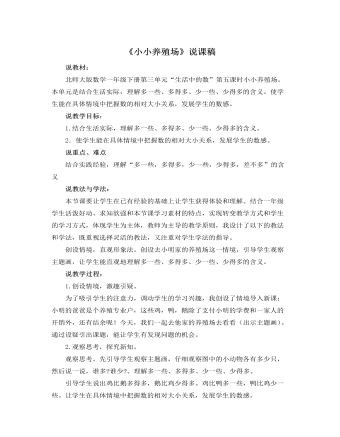
北师大版小学数学一年级下册《小小养殖场》说课稿
说教材:北师大版数学一年级下册第三单元“生活中的数”第五课时小小养殖场。本单元是结合生活实际,理解多一些、多得多、少一些、少得多的含义。使学生能在具体情境中把握数的相对大小关系,发展学生的数感。说教学目标:1.结合生活实际,理解多一些、多得多、少一些、少得多的含义。2.使学生能在具体情境中把握数的相对大小关系,发展学生的数感。说重点、难点结合实践经验,理解“多一些,多得多,少一些,少得多,差不多”的含义说教法与学法:本节课要让学生在已有经验的基础上让学生获得体验和理解。结合一年级学生活泼好动、求知欲强和本节课学习素材的特点,实现转变教学方式和学生的学习方式,体现学生为主体,教师为主导的教学原则,我设计了以下的教法和学法,既重视选择灵活的教法,又注重对学生学法的指导。
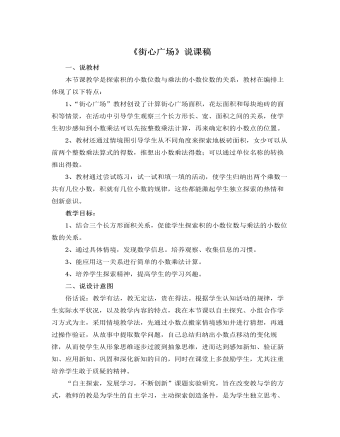
北师大版小学数学四年级下册《街心广场》说课稿
一、说教材本节课教学是探索积的小数位数与乘法的小数位数的关系,教材在编排上体现了以下特点:1、“街心广场”教材创设了计算街心广场面积,花坛面积和每块地砖的面积等情景,在活动中引导学生观察三个长方形长、宽、面积之间的关系,使学生初步感知到小数乘法可以先按整数乘法计算,再来确定积的小数点的位置。2、教材还通过情境图引导学生从不同角度来探索地板砖面积,女少可以从前两个整数乘法算式的得数,推想出小数乘法得数;可以通过单位名称的转换推出得数。3、教材通过尝试练习:试一试和填一填的活动,使学生归纳出两个乘数一共有几位小数,积就有几位小数的规律,这些都能激起学生独立探索的热情和创新意识。教学目标:1、结合三个长方形面积关系,促能学生探索积的小数位数与乘法的小数位数的关系。
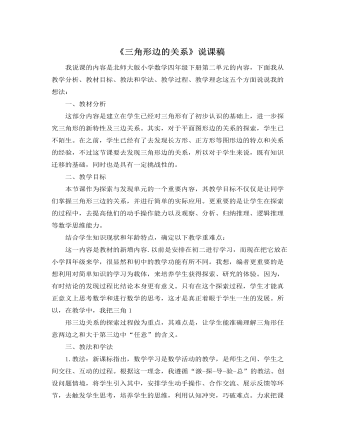
北师大版小学数学四年级下册《三角形边的关系》说课稿
首先出示一些生活中常见的图片,让学生通过欣赏,发现图片里面的三角形,为学生创设情境,从而引出本节课的主角----三角形。然后让学生回忆什么样的图形是三角形?使学生在头脑里迅速的呈现出三角形的概念“由三条线段首尾连接围成的图形叫三角形”。在此强调“首尾连接”。这样由三角形的定义再现三角形的表象,明白三角形围摆的要求,避免学生在操作过程中出现过失性的错误。紧接着抛出一个问题,制造一个问题情境“给你三条线段,你一定能围成一个三角形吗?”对于这个问题,学生可能会做出各种猜测,但我不作任何表态。我利用学生思维中可能出现的错误,创设了这样一个认知矛盾的冲突。因为学生原本以为只要有三条线段,就能围成三角形,但通过老师的演示和自己动手操作,发现并不是有三条线段就能围成三角形,使学生的认知结构受到了严重的冲击,自然而然的引出要解决的问题:那三角形三边有什么关系?并板书课题。第二个环节,实验操作,积累研究的材料。
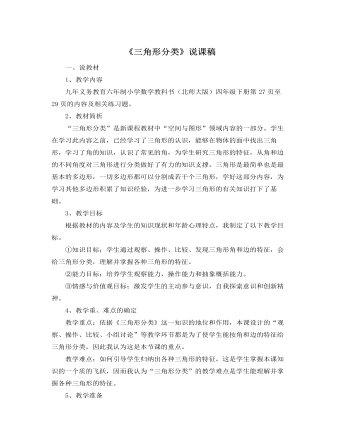
北师大版小学数学四年级下册《三角形分类》说课稿
1、教学内容九年义务教育六年制小学数学教科书(北师大版)四年级下册第27页至29页的内容及相关练习题。2、教材简析“三角形分类”是新课程教材中“空间与图形”领域内容的一部分。学生在学习此内容之前,已经学习了三角形的认识,能够在物体的面中找出三角形,学习了角的知识,认识了常见的角,为学生研究三角形的特征,从角和边的不同角度对三角形进行分类做好了有力的知识支撑。三角形是最简单也是最基本的多边形,一切多边形都可以分割成若干个三角形,学好这部分内容,为学习其他多边形积累了知识经验,为进一步学习三角形的有关知识打下了基础。3、教学目标根据教材的内容及学生的知识现状和年龄心理特点,我制定了以下教学目标。①知识目标;学生通过观察、操作、比较、发现三角形角和边的特征,会给三角形分类,理解并掌握各种三角形的特征。
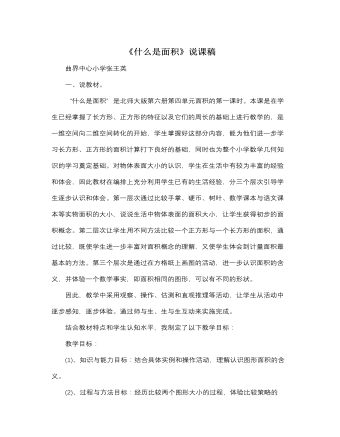
北师大版小学数学三年级下册《什么是面积》说课稿
一、说教材。“什么是面积”是北师大版第六册第四单元面积的第一课时。本课是在学生已经掌握了长方形、正方形的特征以及它们的周长的基础上进行教学的,是一维空间向二维空间转化的开始,学生掌握好这部分内容,能为他们进一步学习长方形、正方形的面积计算打下良好的基础,同时也为整个小学数学几何知识的学习奠定基础。对物体表面大小的认识,学生在生活中有较为丰富的经验和体会,因此教材在编排上充分利用学生已有的生活经验,分三个层次引导学生逐步认识和体会。第一层次通过比较手掌、硬币、树叶、数学课本与语文课本等实物面积的大小,说说生活中物体表面的面积大小,让学生获得初步的面积概念。第二层次让学生用不同方法比较一个正方形与一个长方形的面积,通过比较,既使学生进一步丰富对面积概念的理解,又使学生体会到计量面积最基本的方法。第三个层次是通过在方格纸上画图的活动,进一步认识面积的含义,并体验一个数学事实,即面积相同的图形,可以有不同的形状。
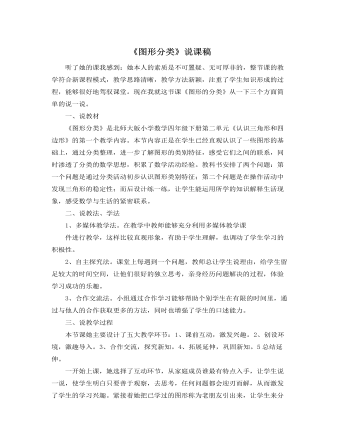
北师大版小学数学四年级下册《图形分类》说课稿
一、说教材《图形分类》是北师大版小学数学四年级下册第二单元《认识三角形和四边形》的第一个教学内容。本节内容正是在学生已经直观认识了一些图形的基础上,通过分类整理,进一步了解图形的类别特征,感受它们之间的联系,同时渗透了分类的数学思想,积累了数学活动经验。教科书安排了两个问题:第一个问题是通过分类活动初步认识图形类别特征;第二个问题是在操作活动中发现三角形的稳定性;而后设计练一练,让学生能运用所学的知识解释生活现象,感受数学与生活的紧密联系。二、说教法、学法1、多媒体教学法。在教学中教师能够充分利用多媒体教学课件进行教学,这样比较直观形象,有助于学生理解,也调动了学生学习的积极性。2、自主探究法。课堂上每遇到一个问题,教师总让学生说理由,给学生留足较大的时间空间,让他们很好的独立思考,亲身经历问题解决的过程,体验学习成功的乐趣。
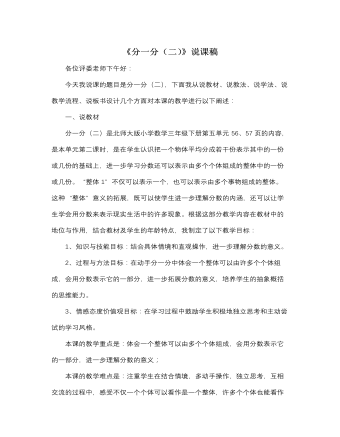
北师大版小学数学三年级下册《分一分(二)》说课稿
本环节我依据教学目标和学生对知识的掌握情况,我设计了有针对性、层次分明的练习题(基本题、变式题、拓展题),让学生在解决这些问题的过程中,进一步理解,巩固新知,训练思维的灵活性,使学生的探索精神和实践能力得到进一步的提高。[本环节的设计意图:通过多层次的练习,激发学生的学习兴趣,调动学生学习的积极性和主动性,使学生获得愉悦的情感体验。同时使学生的知识结构更加完善。]第四环节:课堂小结在轻松愉快的学习活动结束后,我会与学生进行总结对话“这节课你有什么收获?你学会了什么?还有什么不懂得地方吗?”学生充分发言,交流自己的学习心得。[本环节的设计意图:帮助学生梳理知识,整理本课的知识要点,完成本节课的教学活动。]
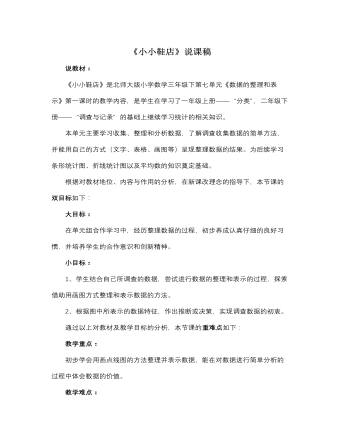
北师大版小学数学三年级下册《小小鞋店》说课稿
(1)喜欢哪种动物的人最多?(2)一共有多少人投票?(3)下面哪一组和上图所表示的数据完全一样?2、发货的工厂给我们推荐了几款比较受欢迎的鞋子,这里有一些调查的数据,你准备采用什么方法来决定这几种款式要进的数量?做一做!(先独立完成再与同伴交流自己的方法)(设计理念:通过本节课创设的情景,很自然地引出一个习题和课下作业,并不是很生硬地为了练习而练习,而是让学生感受到现实存在的问题需要利用所学的知识去解决,这样不仅能巩固所学知识,还能让学生再次体会统计的必要性。)说板书设计:板书设计在教学中起到了画龙点睛的作用,因此,我设计概括点拨式的板书来归纳本节课的中心内容,这样设计层次分明、重点突出,有利于巩固学生对新知识的掌握。
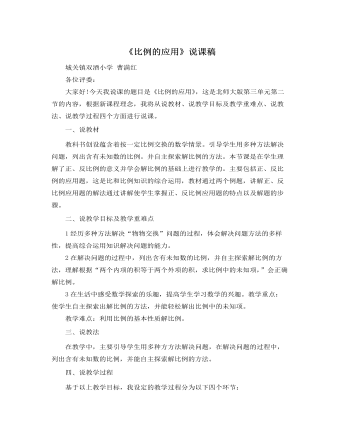
北师大版小学数学六年级下册《比例的应用》说课稿
一、说教材教科书创设蕴含着按一定比例交换的数学情景。引导学生用多种方法解决问题,列出含有未知数的比例。并自主探索解比例的方法。本节课是在学生理解了正、反比例的意义并学会解比例的基础上进行教学的。主要包括正、反比例的应用题,这是比和比例知识的综合运用,教材通过两个例题,讲解正、反比例应用题的解法通过讲解使学生掌握正、反比例应用题的特点以及解题的步骤。二、说教学目标及教学重难点1经历多种方法解决“物物交换”问题的过程,体会解决问题方法的多样性,提高综合运用知识解决问题的能力。2在解决问题的过程中,列出含有未知数的比例,并自主探索解比例的方法,理解根据“两个内项的积等于两个外项的积,求比例中的未知项,”会正确解比例。3在生活中感受数学探索的乐趣,提高学生学习数学的兴趣。教学重点:使学生自主探索出解比例的方法,并能轻松解出比例中的未知项。
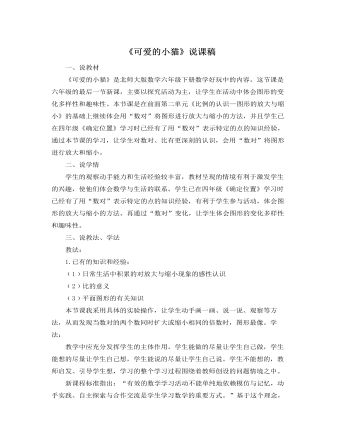
北师大版小学数学六年级下册《可爱的小猫》说课稿
设计意图:通过观察,能够发现并概括规律。培养学生的观察和归纳能力。校对表格后,让学生猜想一下天天、晶晶和欢欢的轮廓图谁和乐乐更像呢?为什么?设计意图:通过猜一猜,让学生带着猜测进行下一个活动。活动3:动手操作画出三只小猫的轮廓。(1)明确小组分工,2个人画天天、2个人画晶晶、2个人画欢欢,独立操作画图,根据每只小猫轮廓的点的数对用铅笔描点,并用直尺画出它们的轮廓图。(2)观察比较四幅轮廓图,小组讨论这三只小猫的轮廓图与乐乐的不同点,交流总结规律。说说哪只长得像乐乐,为什么?(3)集中反馈,验证猜测。设计意图:通过画一画让学生验证自己的猜测,体会用数对的方法将图形放大,并且引导学生发现当数对的两个数扩大相同的倍数时,画出来的图形和原来像。这样通过使学生动手实践,自主探究,合作交流,培养了学生的操作画图能力和概括归纳能力,有效的落实了本节课的教学目标。
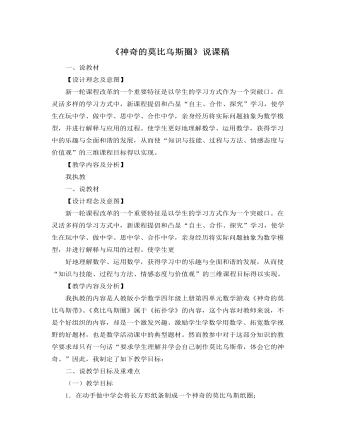
北师大版小学数学六年级下册《神奇的莫比乌斯圈》说课稿
一、说教材【设计理念及意图】新一轮课程改革的一个重要特征是以学生的学习方式作为一个突破口。在灵活多样的学习方式中,新课程提倡和凸显“自主、合作、探究”学习,使学生在玩中学、做中学、思中学、合作中学,亲身经历将实际问题抽象为数学模型,并进行解释与应用的过程。使学生更好地理解数学、运用数学,获得学习中的乐趣与全面和谐的发展,从而使“知识与技能、过程与方法、情感态度与价值观”的三维课程目标得以实现。一、说教材【设计理念及意图】新一轮课程改革的一个重要特征是以学生的学习方式作为一个突破口。在灵活多样的学习方式中,新课程提倡和凸显“自主、合作、探究”学习,使学生在玩中学、做中学、思中学、合作中学,亲身经历将实际问题抽象为数学模型,并进行解释与应用的过程。使学生更好地理解数学、运用数学,获得学习中的乐趣与全面和谐的发展,从而使“知识与技能、过程与方法、情感态度与价值观”的三维课程目标得以实现。
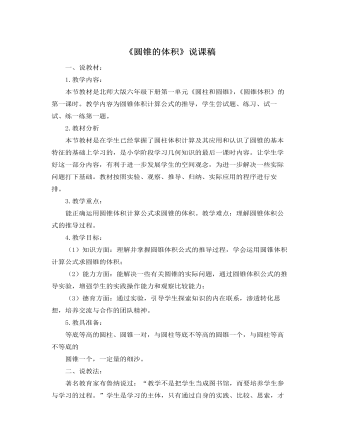
北师大版小学数学六年级下册《圆锥的体积》说课稿
1.教学内容:本节教材是北师大版六年级下册第一单元《圆柱和圆锥》,《圆锥体积》的第一课时。教学内容为圆锥体积计算公式的推导,学生尝试题、练习、试一试、练一练第一题。2.教材分析本节教材是在学生已经掌握了圆柱体积计算及其应用和认识了圆锥的基本特征的基础上学习的,是小学阶段学习几何知识的最后一课时内容。让学生学好这一部分内容,有利于进一步发展学生的空间观念,为进一步解决一些实际问题打下基础。教材按照实验、观察、推导、归纳、实际应用的程序进行安排。3.教学重点:能正确运用圆锥体积计算公式求圆锥的体积。教学难点:理解圆锥体积公式的推导过程。4.教学目标:(1)知识方面:理解并掌握圆锥体积公式的推导过程,学会运用圆锥体积计算公式求圆锥的体积;
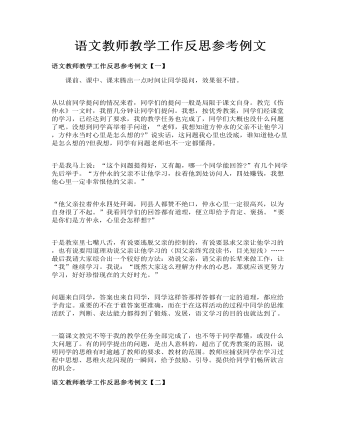
语文教师教学工作反思参考例文
于是我马上说:“这个问题提得好,又有趣,哪一个同学能回答?”有几个同学先后举手。“方仲永的父亲不让他学习,拉着他到处访问人,四处赚钱,我想他心里一定非常恨他的父亲。” “他父亲拉着仲永四处拜谒,同县人都赞不绝口,仲永心里一定很高兴,以为自身很了不起。”我看同学们的回答都有道理,便立即给予肯定、褒扬。“要是你们是方仲永,心里会怎样想?”

新人教版高中英语必修3Unit 4 Space Exploration-Discovering Useful Structure教学设计
The theme of the section is “Describe space facts and efforts to explore space”. Infinitives are one of non-finite verbs, as the subjects, objects, predicative, attributes and adverbials. This unit is about space exploration, which is a significant scientific activity, so every scientific activity has strong planning. Therefore, using the infinitives to show its purpose, explanations or restrictions is the best choice.1. Learn the structure, functions and features of infinitives.2. Learn to summarize some rules about infinitives to show purpose and modify.3. Learn to use infinitives in oral and writing English. 1. Learn the structure, functions and features of infinitives.2. Learn to summarize some rules about infinitives to show purpose and modify.3. Learn to use use infinitives in oral and writing English.Step 1 Lead in---Pair workLook at the following sentences and focus on the italicized infinitives. In pairs, discuss their functions. 1. I trained for a long time to fly airplanes as a fighter pilot..(作目的状语)2. As we all know, an astronaut needs to be healthy and calm in order to work in space..(作目的状语)3. First of all, you must be intelligent enough to get a related college degree..(作目的状语)4. Some scientist were determined to help humans realise their dream to explore space..(作定语)5. On 12 April 1961, Yuri Gagarin became the first person in the world to go into space..(作定语)Summary:1. 不定式的结构:to+do原形。2. 分析上面的句子,我们知道在描述太空探索时,动词不定式不仅可以用来表目的,还可以用来作定语,表修饰。

新人教版高中英语选修2Unit 3 Food and Culture-Discovering useful structures教学设计
The newspaper reported more than 100 people had been killed in the thunderstorm.报纸报道说有一百多人在暴风雨中丧生。(2)before、when、by the time、until、after、once等引导的时间状语从句的谓语是一般过去时,以及by、before后面接过去的时间时,主句动作发生在从句的动作或过去的时间之前且表示被动时,要用过去完成时的被动语态。By the time my brother was 10, he had been sent to Italy.我弟弟10岁前就已经被送到意大利了。Tons of rice had been produced by the end of last month. 到上月底已生产了好几吨大米。(3) It was the first/second/last ... time that ...句中that引导的定语从句中,主语与谓语构成被动关系时,要用过去完成时的被动语态。It was the first time that I had seen the night fact to face in one and a half years. 这是我一年半以来第一次亲眼目睹夜晚的景色。(4)在虚拟语气中,条件句表示与过去事实相反,且主语与谓语构成被动关系时,要用过去完成时的被动语态。If I had been instructed by him earlier, I would have finished the task.如果我早一点得到他的指示,我早就完成这项任务了。If I had hurried, I wouldn't have missed the train.如果我快点的话,我就不会误了火车。If you had been at the party, you would have met him. 如果你去了晚会,你就会见到他的。

新人教版高中英语必修3Unit 1 Festivals and celebrations-Discovering Useful Structure教学设计
4.That was an experience that frightened everyone. →That was _____________________. 答案:1. taking 2. being discussed 3. in the reading room 4. a frightening experienceStep 6 The meaning and function of V-ing as the predicative动词-ing形式作表语,它通常位于系动词后面,用以说明主语“是什么”或“怎么样”一种表示主语的特质、特征和状态, 其作用相当于形容词; 另一种具体说明主语的内容, 即主语等同于表语, 两者可互换。The music they are playing sounds so exciting. 他们演奏的音乐听起来令人激动。The result is disappointing. 结果令人失望。Our job is playing all kinds of music. 我们的工作就是演奏各种音乐。Seeing is believing. 眼见为实。Step 7 Practice1. It is ________(amaze) that the boy is able to solve the problem so quickly.2. Buying a car is simply _______(waste) money. 3. Please stop making the noise—it’s getting ________(annoy). 4. complete the passage with the appropriate -ing form.La Tomatina is a festival that takes place in the Spanish town Bunol every August. I think many food festivals are __________ because people are just eating. however, this festival is _________ because people don't actually eat the tomatoes. Instead, they throw them at each other! the number of people ________ part in this tomato fight, can reach up to 20,000, and it is a very __________ fight that lasts for a whole hour. The _______ thing is how clean Bunol is after the tomatoes are washed away after the fight. this is because the juice form tomatoes is really good for making surfaces clean!答案:1. amazing 2. wasting 3. annoying4. boring interesting taking exciting amazing

新人教版高中英语必修3Unit 1 Festivals and Celebrations-Reading and Thinking教学设计
The topic of this part is “Discover the reasons for festivals and celebrations.The Listening & Speaking & Talking part aims at talking about the experiences and feelings or emotions about the festivals and celebrations. This section aims at detecting the reason why the people celebrate the festivals, the time, the places, the types and the way of celebrations. It also explains why some traditions in the old celebrations are disappearing, like the firecrackers in the big cities and some new things are appearing like the prosperity of business or commerce. 1. Students can talk about what festivals they know and the reasons and the way of celebrating them.2. Students should learn the reading skills such as the headline and get the topic sentences, the structures of articles.3. Students can understand the past, the present situation of some festival around the world and why there are some changes about them. 4. Students can have the international awareness about the festivals.1. Students should learn the reading skills such as the headline and get the topic sentences, the structures of articles.2. Students can understand the past, the present situation of some festival around the world and why there are some changes about them.Step 1 Lead in---Small talkWhat festival do you like best ? Why ?I like the Spring Festivals because I can set off the fireworks, receive the lucky money and enjoy the Gala with my families.Step 2 Before reading---Pair workWhy do people celebrate different festivals ?The Spring Festivals is to celebrate the end of winter and the coming of spring and new life.The Mid-autumn Day is to celebrate the harvest and admire the moon.

新人教版高中英语必修3Unit 1 Festivals and Celebrations-Listening &Speaking&Talking教学设计
The theme of this section is “Talk about festival activities and festival experiences”.Festival and holiday is a relaxing and interesting topic for students. This part talks about the topic from the daily life of students’. In the part A ---Listening and Speaking, there are three conversations among different speakers from three countries(Japan, Rio and China), where the speakers are participating in or going to participate in the festivals and celebrations. So listening for the relationship among them is a fundamental task. Actually, with the globalization and more international communication, it is normal for Chinese or foreigners to witness different festivals and celebrations in or out of China. In the Conversation 1, a foreign reporter is interviewing a Japanese young girl who just had participated in the ceremony of the Coming-of-Age Day on the street and asking her feeling about the ceremony and the afterwards activities. Conversation 2, Chinese girl Li Mei is witnessing the Rio Carnival for the first time, and her friend Carla gives her some advice on the costumes which enables her to match with the carnival to have a good time. Conversation 3, a Chinese guide is showing a group of foreign visitors around the Lantern Festival and introducing the customs of the festival to them. The three conversations have a strong vitality and insert the festival and cultural elements from different countries. So perceiving the festivals and cultures from different countries is the second task. At the same time, the scripts also insert the targeted grammar --- v-ing as attributive and predicative, which students can perceive and experience in a real context and make a road for the further study. That is the third task. In the Part B--- Listening and Talking, the theme is “Talk about festival experience”, which is the common topic in our daily conversations. During the conversation, Song Lin, a Chinese student, asked Canadian friend Max about how to spend Christmas. In the conversation, Song Lin talked about experience and the feelings during the Chinese Spring Festival, during which there are not only some enjoyable things but some unpleasant things. After the listening, perhaps students find there are some similarities between Christmas and the Chinese Spring Festival as there are some differences in the origins and celebrations. For example, people always visit friends and relatives, decorate their houses, have a big dinner together, chat and give presents to each other.

新人教版高中英语必修3Unit 1 Festivals and Celebrations-Reading for writing教学设计二
Step 3 Analyzing article structureActivity 31. Teachers raise questions to guide students to analyze the chapter structure of this diary and think about how to describe the festival experience. (1)What should be included in the opening/body/closing paragraph(s)?(2)How did the writer arrange his/her ideas?(3)What kind of interesting details did the writer describe?(4)How did the writer describe his/her feelings/emotions during the event?2. Students read and compare the three sentence patterns in activity 2. Try to rewrite the first paragraph of the diary with these three sentence patterns. After that, students exchange corrections with their partners. Such as:●This was my first time spending three days experiencing the Naadam Festival in China’s Inner Mongolia Autonomous Region and it was an enjoyable and exciting experience. ●I'll never forget my experience at the Naadam Festival because it was my first time to watch the exciting Mongolian games of horse racing, wrestling, and archery so closely. ●I'll always remember my first experience at the Naadam Festival in China’s Inner Mongolia Autonomous Region because it was so amazing to spend three days witnessing a grand Mongolian ceremony. Step 4 Accumulation of statementsActivity 41. Ask the students to read the diary again. Look for sentences that express feelings and emotions, especially those with the -ing form and the past participle. Such as:● …horse racing, wrestling, and archery, which are all so exciting to watch. ● some amazing performances● I was surprised to see…● I was a little worried about. . . ● feeling really tiredOther emotional statements:●I absolutely enjoyed the archery, too, but the horse races were my favourite part. ●I'm finally back home now, feeling really tired, but celebrating Naadam with my friend was totally worth it. ●He invited me back for the winter to stay in a traditional Mongolian tent and cat hot pot. I can’t wait!2. In addition to the use of the -ing form and the past participle, the teacher should guide the students in the appreciation of these statements, ask them to memorize them, and encourage them to use them reasonably in writing practice.

新人教版高中英语必修3Unit 1 Festivals and Celebrations-Reading for Writing教学设计一
The topic of this part is “Write about your festival experience”.During the Listening and Speaking and Talking, students are just asked to say out their festival experiences such as the Spring Festival, Mid-autumn Day, but this part students will be asked to write down their own festival experiences. During the reading part, it introduces the Naadam Festival in Inner Mongolia Autonomous Region, which can give students a good example to imitate. Students not only learn the festival, but touch and feel the Inner Mongolian’s character, the spirit and cultural atmosphere, which can help students form the cultural awareness and learn to enjoy and value the diversity of Chinese culture.Concretely, the dairy tells the experience that the author spent the Naadam Festival in Inner Mongolia Autonomous Region with his/her friend. The structure is clear. In the opening paragraph, it introduces the topic of the Naadam Festival and the whole feeling. Then it introduces the items of the festival like the ceremony, wrestling and horse racing. Finally, it summarizes this experience. Because this part is a travel journal, we must guide students pay more attention to these details: 1. use the first person. 2. use the past tense to tell the past thing and use the present or future tense to describe the scenery. 3. use the timeline to tell the development. 4. be careful for the author’s psychology, emotion and feeling, etc.1. Read quickly to get main idea; read carefully to get the detailed information about Naadam Festival.2. Learn the structure of the reading article and language.3. Write an article about a festival experience4. Learn to use the psychology, emotions and feeling in the writing.1. Write an article about a festival experience.2. Use the structure of the reading article and language.

